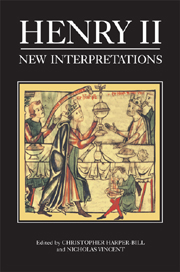Book contents
- Frontmatter
- Contents
- List of Illustrations
- Editor's Preface
- List of Abbreviations
- Introduction: Henry II and the Historians
- The Accession of Henry II
- Henry II and Louis VII
- Doing Homage to the King of France
- Henry, Duke of the Normans (1149/50–1189)
- Henry II and England's Insular Neighbours
- Henry II, the English Church and the Papacy, 1154–76
- On the Instruction of a Prince: The Upbringing of Henry, the Young King
- Henry II and the Creation of the English Common Law
- Finance and the Economy in the Reign of Henry II
- Henry II and the English Coinage
- The Court of Henry II
- Literary Culture at the Court of Henry II
- Henry II and Arthurian Legend
- Index
Henry II and England's Insular Neighbours
Published online by Cambridge University Press: 12 September 2012
- Frontmatter
- Contents
- List of Illustrations
- Editor's Preface
- List of Abbreviations
- Introduction: Henry II and the Historians
- The Accession of Henry II
- Henry II and Louis VII
- Doing Homage to the King of France
- Henry, Duke of the Normans (1149/50–1189)
- Henry II and England's Insular Neighbours
- Henry II, the English Church and the Papacy, 1154–76
- On the Instruction of a Prince: The Upbringing of Henry, the Young King
- Henry II and the Creation of the English Common Law
- Finance and the Economy in the Reign of Henry II
- Henry II and the English Coinage
- The Court of Henry II
- Literary Culture at the Court of Henry II
- Henry II and Arthurian Legend
- Index
Summary
In the inimitable words of the inimitable John Gillingham, ‘No view of Henry II in the first half of his reign is more misleading than one which sees him as a peace-loving, stay-at-home king.’ As an unapologetic devotee of chronicles and related genre, Professor Gillingham was no doubt persuaded to such a view by prolonged exposure to the observations of men like Gerald of Wales. It was, after all, Gerald's belief that power such as that attained by Henry II had never previously been wielded by any king of England, not since the Norman Conquest, not even since the Anglo-Saxon invasions:
[Henry] triumphed over realms remote and alien, which pertained to none of his predecessors, from the arrival of the Normans, or even of the Angles. Crossing the deep sea, he visited Ireland with a fleet, and gloriously subdued it. Scotland also he vanquished, capturing its king, William. And, adding to the English Crown an increment so noble beyond precedent, he remarkably extended the kingdom's limits and boundaries, from the ocean on the south to the Orkney islands on the north, with powerful grasp including the whole island of Britain in one monarchy.
As Gerald states, nowhere are Henry's ‘peace-loving, stay-at-home’ attributes less in evidence than in his dealings with England's insular neighbours. Let us glance first at Scotland.
The Scottish claim to what is now northern England was, of course, one of the great issues in diplomatic relations between the two countries throughout the twelfth century and beyond.
- Type
- Chapter
- Information
- Henry IINew Interpretations, pp. 129 - 153Publisher: Boydell & BrewerPrint publication year: 2007



